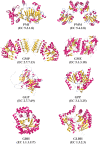Genetic and biochemical strategies for regulation of L-ascorbic acid biosynthesis in plants through the L-galactose pathway
- PMID: 37021310
- PMCID: PMC10069634
- DOI: 10.3389/fpls.2023.1099829
Genetic and biochemical strategies for regulation of L-ascorbic acid biosynthesis in plants through the L-galactose pathway
Abstract
Vitamin C (L-ascorbic acid, AsA) is an essential compound with pleiotropic functions in many organisms. Since its isolation in the last century, AsA has attracted the attention of the scientific community, allowing the discovery of the L-galactose pathway, which is the main pathway for AsA biosynthesis in plants. Thus, the aim of this review is to analyze the genetic and biochemical strategies employed by plant cells for regulating AsA biosynthesis through the L-galactose pathway. In this pathway, participates eight enzymes encoded by the genes PMI, PMM, GMP, GME, GGP, GPP, GDH, and GLDH. All these genes and their encoded enzymes have been well characterized, demonstrating their participation in AsA biosynthesis. Also, have described some genetic and biochemical strategies that allow its regulation. The genetic strategy includes regulation at transcriptional and post-transcriptional levels. In the first one, it was demonstrated that the expression levels of the genes correlate directly with AsA content in the tissues/organs of the plants. Also, it was proved that these genes are light-induced because they have light-responsive promoter motifs (e.g., ATC, I-box, GT1 motif, etc.). In addition, were identified some transcription factors that function as activators (e.g., SlICE1, AtERF98, SlHZ24, etc.) or inactivators (e.g., SlL1L4, ABI4, SlNYYA10) regulate the transcription of these genes. In the second one, it was proved that some genes have alternative splicing events and could be a mechanism to control AsA biosynthesis. Also, it was demonstrated that a conserved cis-acting upstream open reading frame (5'-uORF) located in the 5'-untranslated region of the GGP gene induces its post-transcriptional repression. Among the biochemical strategies discovered is the control of the enzyme levels (usually by decreasing their quantities), control of the enzyme catalytic activity (by increasing or decreasing its activity), feedback inhibition of some enzymes (GME and GGP), subcellular compartmentation of AsA, the metabolon assembly of the enzymes, and control of AsA biosynthesis by electron flow. Together, the construction of this basic knowledge has been establishing the foundations for generating genetically improved varieties of fruits and vegetables enriched with AsA, commonly used in animal and human feed.
Keywords: ascorbate biosynthesis; genetic control; metabolic pathways; regulation; vitamin C.
Copyright © 2023 Castro, Castro and Cobos.
Conflict of interest statement
The authors declare that the research was conducted in the absence of any commercial or financial relationships that could be construed as a potential conflict of interest.
Figures





References
-
- Aniceto A., Montenegro J., Cadena R., da S., Teodoro A. J. (2021). Physicochemical characterization, antioxidant capacity, and sensory properties of murici (Byrsonima crassifolia (L.) kunth) and taperebá (Spondias mombin l.) beverages. Molecules 26, E332. doi: 10.3390/molecules26020332 - DOI - PMC - PubMed
Publication types
LinkOut - more resources
Full Text Sources
Research Materials

